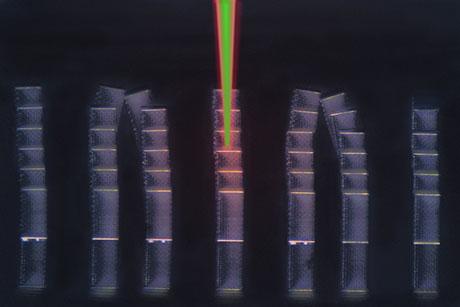Student Spotlight: Paul Lazarescu
A Modern-Day Inventor
by Jessica Fujimara, MIT News Office

Photo credit: Allegra Boverman
As a child, Paul Lazarescu (SB ‘13) dreamed of becoming an inventor.
“I always loved building things,” he says. “For my birthday presents, I’d get remote-control cars and kits, and I once tried to make myself a hovering magnetic car — it didn’t work,” he chuckles.
Now a recent MechE graduate, Lazarescu is on the way to achieving his childhood dream: He’s designed a hand exerciser for stroke rehabilitation, a wheelchair attachment for off-road travel, and a structure for mounting NASA sensors on airplanes.
When he’s not busy with classes and internships, Lazarescu spends time with his fraternity brothers in Alpha Epsilon Pi, where he recently finished a term as vice president, or practicing one of his many hobbies: juggling, blacksmithing, scuba diving, playing the guitar, breakdancing, and krav maga, an Israeli system of self-defense. “I love learning new things and picking up random talents here and there,” Lazarescu says.
Wheels Turning
One pastime Lazarescu never thought he’d try was wheelchair basketball. But the summer after his sophomore year, he found himself in a small town in Guatemala, huffing from one side of the court to the other.
Lazarescu and current MechE undergraduate Rachel Dias Carlson had received funding from the MIT Public Service Center for travel to Antigua, Guatemala, to work on low-cost, rugged wheelchair designs.
Lazarescu worked on a large wheel that attaches to the front of a wheelchair. “It’s like a little bike tire; you can go on gravel and everything that the little wheels wouldn’t be able to deal with,” he says. In the United States, such an attachment costs around $500, far out of reach for poorer populations in Guatemala. “In the end, we made something that could be produced and sold for $50,” Lazarescu says.
Later that summer, he worked at the University of California at Irvine, where he helped design a device that employs a spinning wheel to help stroke victims recover their ability to grip with their hands.
“Many people who have had strokes have issues opening their hands and other things that we take for granted, like holding a pencil or picking up keys,” Lazarescu explains. The wheel on his device connects to a handgrip, and the spinning of the wheel opens and closes the grip. A patient holding the handgrip could then practice timing the opening and closing of his or her hand to match the spinning of the wheel.
Sensors in the Sky
The following January, Lazarescu’s attention shifted from the ground to the air. As an intern at NASA’s Goddard Space Flight Center, he worked on designs for attaching two microwave radiation sensors to an airplane that would fly over ocean and land to measure salinity and water content, respectively. The data from the sensors would then be used to calibrate a similar sensor on a satellite currently in orbit.
Although he loves engineering, Lazarescu has also nurtured an interest in business during his time in MechE, founding an investing club his junior year. This summer, he is starting as a business analyst at consulting firm McKinsey & Company. One day, Lazarescu hopes to create his own startup, “an engineering, cutting-edge company that makes a big impact through inventions and innovation,” he says.
Watch a video of his hand exerciser at http://youtu.be/AaaCkv8jgcI or read the original MIT News Office article at http://bit.ly/16XYbnS.

